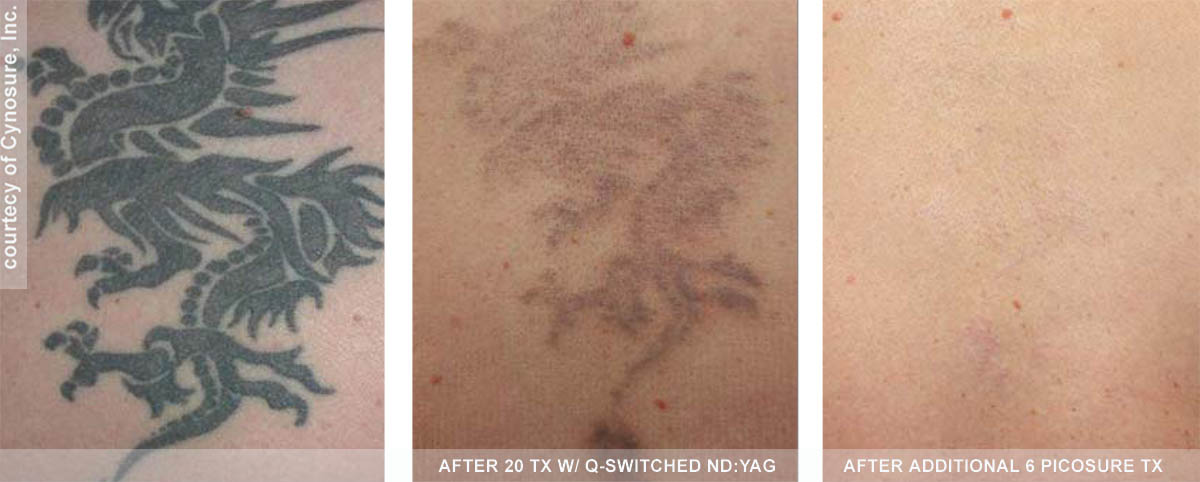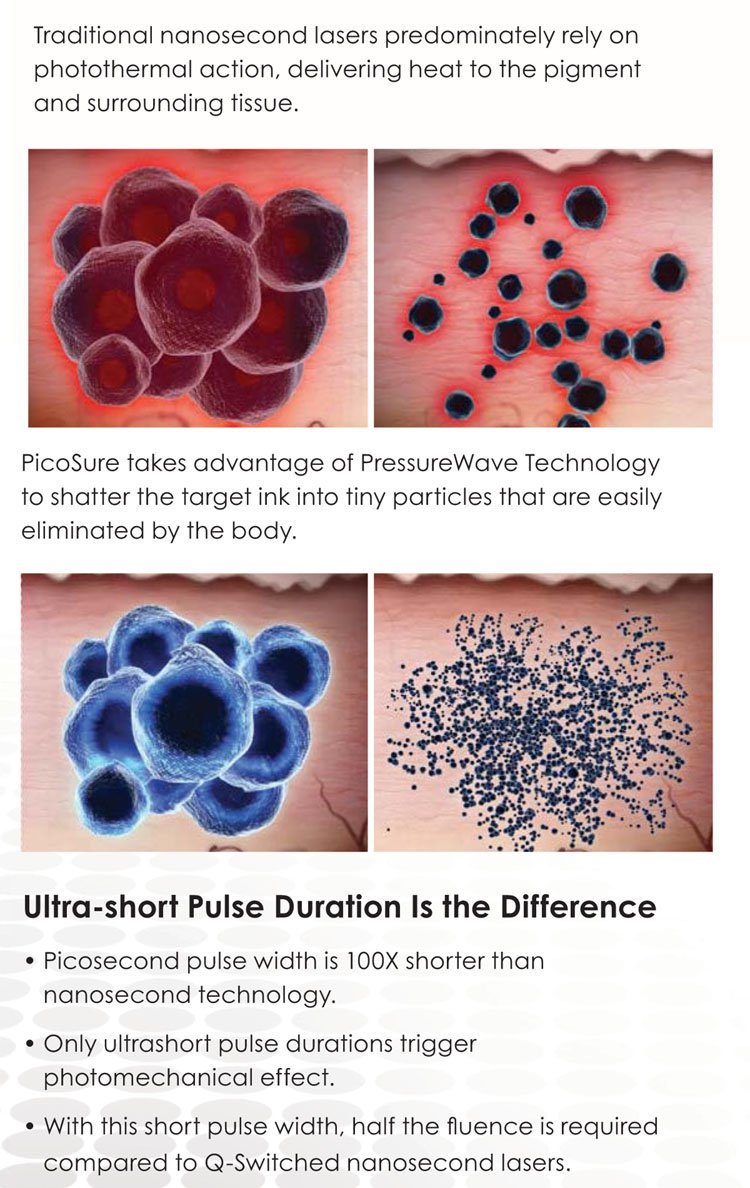Picosure Tattoo Removal - Patients ask, Dr. Ringpfeil answers
Please feel free to use the blog below to share information about Picosure Tattoo Removal or to ask Dr. Franziska Ringpfeil a question that might be of interest to others.



"PicoSure® is the most advanced technology in tattoo removal in 20 years.
With our PicoSure® your benefits are:
Franziska Ringpfeil, MD, Board Certified Dermatologist

| Inches | 1 | 2 | 3 | 4 | 5 | 6 | 7 | 8 | 9 | 10 |
|---|---|---|---|---|---|---|---|---|---|---|
| Price | $150 | $180 | $210 | $240 | $270 | $300 | $330 | $360 | $390 | $420 |
| Inches | 11 | 12 | 13 | 14 | 15 | 16 | 17 | 18 | 19 | 20 |
|---|---|---|---|---|---|---|---|---|---|---|
| Price | $450 | $480 | $510 | $540 | $570 | $600 | $630 | $660 | $690 | $720 |
| Inches | 21 | 22 | 23 | 24 | 25 | 26 | 27 | 28 | 29 | 30 |
|---|---|---|---|---|---|---|---|---|---|---|
| Price | $730 | $740 | $750 | $760 | $770 | $780 | $790 | $800 | $810 | $820 |
| Ringpfeil | Others | ||
|---|---|---|---|
 Price |
$$ | $$ | |
 Providers Providers |
dermatologists + licensed aestheticians |
Vendor trained technicians | |
 Experience Experience |
Since 1999 1st Pico in PA |
Varies | |
 Tattoo Colors Tattoo Colors |
All colors | Depends on lasers used | The only to offer two Picosecond lasers: 1. Picosure 2. Enlighten |
 Stubborn Tattoos Stubborn Tattoos |
Multiple options | Using single laser | The only one to use 5 different lasers (vs. a single Q-Switch) to break the pigment of stubborn tattoos |
 Tattoo Scaring Tattoo Scaring |
Offer scar treatment | Not treating scars |
PicoSure®'s patented PressureWave™ results in better and faster skin clearance with fewer treatments, less laser energy, and less trauma to the skin. Even dark, stubborn blue and green inks, as well as previously treated, recalcitrant tattoos can be removed.
Oh my goodness!!! That is amazing! I cannot believe the difference with one treatment.
You were right. The second treatment healed much faster and didn't even blister. The band-aid adhesive was more of an issue for me than the tattoo.
Thank you for helping me get rid of my 19-year-old impulse.
Got tattoo removal elsewhere and you experience side effects?
We specialize in the treatment of pigmentat correction.
PicoSure® is the only laser using picosecond pulse duration to remove tattoos. Unlike older technologies that create heat while breaking the tattoo pigment, PicoSure® creates an intense photomechanical impact that shatters the tattoo pigment into smaller pieces. It is now easier for your cells to remove the smaller pieces and for your skin to get back to its normal color faster.

Picosure removes all tattoo colors, including green, blue, and yellow. Picosure is the go-to laser for people who are frustrated by not being able to clear their tattoos with the traditional Q-Switched technologies (Q-Switched ND:YAG and Q-Switched Alexandrite).


Tattoos can be removed by tattoo removal lasers, excision, or by tattooing over the existing tattoo. Recently, makeup was developed that completely camouflages tattoos as well.
The total cost depends on the cost per treatment and the number of treatments needed to achieve desired results.
The cost per treatment is determined by the size of the tattoo.
The number of treatments is a factor of color variation and ink density.
Using the Picosure laser enables us to deliver results in fewer treatments and for an overall lower cost to our customers compared to the traditional Q-switched tattoo removal lasers.
To obtain a cost estimate for treatment sessions and the total number of treatments required for the removal of your tattoo, simply load a picture of your tattoo here, and book a free consultation with one of our expert consultants.
It takes 3-7 treatments with the Picosure laser and between 6-20 treatments with the traditional Q-switched tattoo removal lasers (Revlite/Medlite, Trivantage, and others).
Black and dark blue tattoos can be completely removed. Other colors can be more difficult to remove and more treatments are needed to achieve the desired results. The Picosure achieves far better skin clearance than any other tattoo removal laser. Many of our customers who were not successful in getting sufficient clearance with other lasers come to our office to complete their treatment.
Occasionally, the skin pigment in the area of the previous tattoo may appear lighter in color than the untreated skin, creating the illusion of a ghost tattoo. Some of the pigment might come back over time and in most cases, the lighter skin color is barely noticeable.
Historically, laser tattoo removal has been performed by dermatologists. Recently, other physicians and MedSpas have started offering this service in a spa setting. In addition, many tattoo parlors have added laser-assisted tattoo removal to their repertoire.
Tattoo removal lasers are very powerful. A dermatologist will be able to prevent adverse events and minimize foreseeable side effects (such as ghost tattoos). We often see patients who suffered hypertrophic scaring, keloid formation, or complete depigmentation. Some of these adverse events are preventable with proper skin assessments.
Choose an experienced and reputable provider. Make sure they use the most advanced lasers as they are safer and more effective.
Scar formation is common with traditional tattoo removal lasers. It can be as minimal as the destruction of natural pigment in the treated area but hypertrophic scarring is also possible.
The incidence of scar formation with Picosure is minimal or nil compared to the traditional Q-switched lasers because it does not produce heat.
You need to wait at least 6 weeks between treatments when undergoing Picosure treatments. If you are treated with a traditional Q- switched tattoo removal laser, the interval between treatments should be 10 weeks or longer.
The feeling during the laser procedure is similar to that of the tattoo placement.
Most of our customers tolerate the procedure well with an ice pack applied to the treated area just before the procedure. In rare cases, we use forced cold air (Zimmer cooler device) to numb the skin during the procedure. Although applied or injectable numbing medicine is an alternative, the swelling that goes along with the medicine reduces the effectiveness of the treatment.
The tattoo removal laser treatment may create a superficial burn wound. Immediate whitening of the treated area lasts for several minutes. You may experience bruising or swelling. Blisters, crusts, or scabs develop within 8-72 hours and may last for 1-2 weeks. The treated areas may be pink or pale after the scab separates. Hypertrophic scars or even keloids can occur but are very rare. Loss of skin pigment in the treated area can occur and is temporary except in very rare instances. Healing is usually complete within 4 weeks, although this may vary.
Hello,
Can you do work on a tattoo that has been previously removed, but has left some raised scarring along with a pinkish color to the skin.
Scar formation is possible after tattoo removal, especially with the currently available Q-switched lasers. It is not usually seen with the newer generation picosecond lasers.
Raised pink scars may be hypertrophic scars or keloids. A hypertrophic scar usually settles by itself after 2 years without any treatment. A keloid is a genetically determined scar that does not typically settle and may get worse with trauma. The redness in both, hypertrophic scars and keloids, can be treated with a pulsed dye laser. It can take several sessions to remove the redness. Pulsed dye laser treatments also allow for shrinkage of hypertrophic scars and keloids when treated very early after their occurrence. Keloids may often require injections with a steroid or a combination of steroid and another solution to flatten the process. If a keloid formed, additional treatment with the older generation Q-switched lasers for any remaining tattoo pigment is not advisable.
I have read that Picosure does not remove red ink color very well, if at all, does your office have Qswitch laser to combine both lasers to remove red ink color with the Qswitch laser and black ink color with Picosure within a tattoo? Thank you.
I am aware of reports of occasional failure of the picosure laser to clear red pigment. In our practice we get good clearing of red with the picosure. Perhaps the early reports can be attributed to certain red pigment that is truly difficult to remove (red is not all the same pigment). However, I think it may be due to the fact that the early picosure prototype had only one energy level whereas the current model allows us to adjust the levels. If red does not budge with picosure, Q-switched treatment, albeit potentially scarring, can always be a last resort.
I would like to have a newly done tattoo removed. How soon after I received my tattoo may I begin the process? I would like to begin as soon as possible.
In our office, we advise to wait 4 weeks after tattoo placement to start pico laser treatment.
Hi guys
I would like to remove my permanent make up eyebrows completly.
It is really annoying me and im tired of covering it up everyday with make up.
Is that possible and how are the prices for that?
Thank you!
Permanent make up can be removed as long as it is not within the eye socket or near the bony rim. Some permanent make up is rich in iron and can darken with the first treatment before it clears with subsequent treatments. The cost depends on the total size of the permanent make up to be removed. If you have not done so, please set up a complimentary consultation for tattoo removal by phone or in our office be able to learn about all detail and obtain a quote.
What is the typical cost per session? I heard reports on TV of $200-300 per session. I have a tattoo approx 2″ x 1″ of a blue crescent moon with 3 yellow stars I’m looking to get removed.
We currently charge $250 per picosure treatment for a 2 inch x 1 inch tattoo. We also offer complimentary phone consultations so that you can learn about the treatment in detail before your first treatment.
Hi..
i have 3′ tattoo and i would lik to go for picosure treatment .. so my question is how much do you charge and how many session i have to go for and also want to know cost per session.
Thanks.
In general, Picosure clears tattoos in about half or one third of the time of traditional Q switched tattoo removal lasers. Most tattoos require only 6-8 Picosure sessions for clearance. Our current charge is $250 per treatment session for small tattoos that measure up to 3 inch square. Please follow the link for our complimentary online telephone tattoo consultation at https://www.ringpfeildermatology.com/tattoo-removal-picosure.php to get get all the info you need.
Hi Dr. Ringpfeil
I would like to remove my half a sleeve done in green ink, my skin color is brown. How many sessions and how much per session will I have to pay.
Thanks
We offer a complimentary consultation with our aestheticians or a complimentary telephone consultation to obtain this very specific information.
I like my tattoo except for 3 black scrolls that extended outward from it. They are about 2 to 3.5 inches long. Can these be removed without affecting the rest of the tattoo?
Yes, partial removal of a tattoo is possible.
Hi there,
I recently got a tattoo on the middle of my back and automatically knew it was a huge mistake. Is it difficult to get rid of pinks, yellow, purple, orange & white? I’m desperate for help.
It takes a bit longer to get rid of pink and orange compared to all other colors. White can turn brown after the first treatment before it moves away with subsequent treatments.
Hi, how well does the Picosure work on turquoise? I just started a traditional laser tattoo removal, and turquoise isn’t coming off that well.
Thanks
Picosure works well on turquoise colored tattos. We see that it comes out on average after 6 treatments whereas with traditional Q-switched lasers it can take 12-15 treatments.